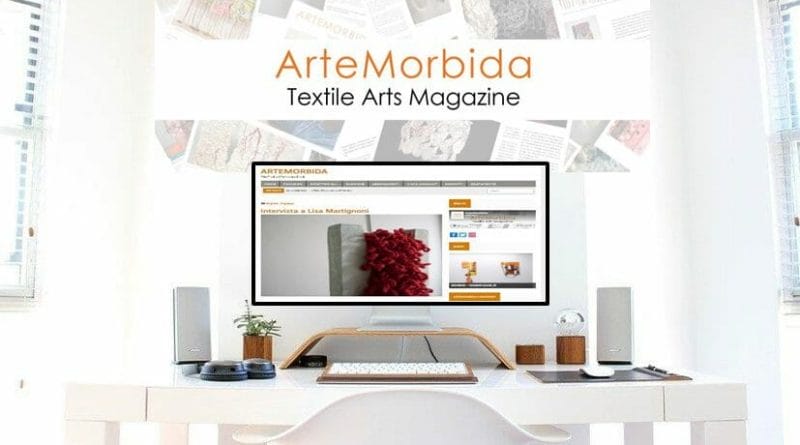ARTEMORBIDA ONLINE VS the QUARTERLY PERIODICAL MAGAZINE
Are you wondering about the difference between ARTEMORBIDA Online and ARTEMORBIDA quarterly magazine, digital or printed?
Here are the answers to all your questions!
ArteMorbida, with its rich thematic offer focusing on contemporary as well as modern and ancient art history, is the ultimate magazine for fibre art and textile art lovers. Daily, the magazine contributes to promoting and disseminating this artistic language and leads enthusiasts, collectors and professionals to discover the relevant key players, artworks, trends and spaces.
A reality in constant and exponential growth, ArteMorbida has seen an increase in collaborations and international media partnerships qualifying it as the focal point of a network of information and active participation within the field.
Under the ArteMorbida umbrella, you can find two publications with different characteristics; discover them here!
The quarterly periodical, digital and print magazine – in its Italian or English version, with in-depth analysis and thematic focus – documents the status quo and evolution of textile art, bidding to become an exhaustive and comprehensive testimony worth collecting.
Each issue gathers insights, essays and texts by selected authors, chosen for their proven knowledge in specific areas of textile art. In each new issue, we focus on a different topic to which at least a quarter of the articles selected for publication is related. For example, our latest and seventh issue focuses on the theme of contemporary tapestry.
In the magazine’s 80 pages, readers can discover this technique’s many facets and evolutions translated into the language of internationally renowned artists. Sheila Pepe, through her interweaving, conveys a feminist perspective and encourages cultural openings aimed at overcoming gender stereotypes, Mimmo Totaro designs and creates elegant and poetic thread geometries in space, Hoda Tawakol expresses herself with organic forms generous and alive with colour, and Goshka Macuga crafts dystopian tapestries for an exhibition at the Fondazione Prada.
Those of you with a keen interest in history will not be disappointed either; each issue features an in-depth focus on art history. This time, our expert Elisa Monfasani leads us to discover the fascinating Marsala Flemish tapestries’ restoration process.
Through carefully choosing subjects and contributors, the periodic quarterly magazine, in digital and print versions, is a precious object and a small artwork in itself. Carefully crafted to the smallest detail, with eye-catching graphics and extremely high-quality images, it is a delight for the mind and senses.
ArteMorbida Online.
By clicking on www.artemorbida.com, you get easy and totally free access to a vast selection of events designed to satisfy your curiosity and keep you up-to-date with the latest international news. A constant overview of calls for proposals, awards and artist residencies will allow you to expand your pool of professional opportunities exponentially. Furthermore, interviews with artists, practitioners, companies, galleries, and museums related to the fibre world will provide you with continuous stimuli and inspiration.
With its dynamism, the ArteMorbida website is an essential tool to nurture your passion for textile art and keep an eye on everything happening in the international fibre art scene.
To give you an idea of the relevance of ArtemMorbida online as a crucial tool for textile art professionals, here is the story of Camilla Cesarini and Contextile. In September 2021, we published the call for entries with all the information and links needed to participate in Contextile 2022. In the meantime, our team carried on its thorough research and documentation work into textile art, scouting the young Camilla Cesarini (aka Armadilly). You can find Barbara Pavan’s exciting interview with the artist at this link: https://www.artemorbida.com/interview-with-armadilly/?lang=en.
Thanks to ArteMorbida, Armadilly learnt about Contextile open call and submitted her pop tapestries to the jury. So, in our May 2022 news article dedicated to the competition’s winners, it was with immense pleasure that we listed her name among the other shortlisted artists https://www.artemorbida.com/contextile-2022-re-make/?lang=en
Armadilly’s artistic journey has not stopped, and we wrote about its developments https://www.artemorbida.com/trust-me-im-a-liar-armadillys-pop-tapestries-on-display-in-perugia/?lang=en.
Our relationship with Contextile developed further, and we became its media partner.
This is just one of many success stories and an example of effective networking powered by our online publication.
Whether you are looking for a new textile title to read, an open call to unleash your creativity, or an artist to inspire you, ArteMorbida, in its online or print/digital edition, has structured its publications to satisfy even the most demanding readers.
If you have questions on how to subscribe, if you would like to collaborate with us or for any further curiosity, please contact our staff at info@artemorbida.com
We look forward to having you among our subscribers! Enjoy your reading!
